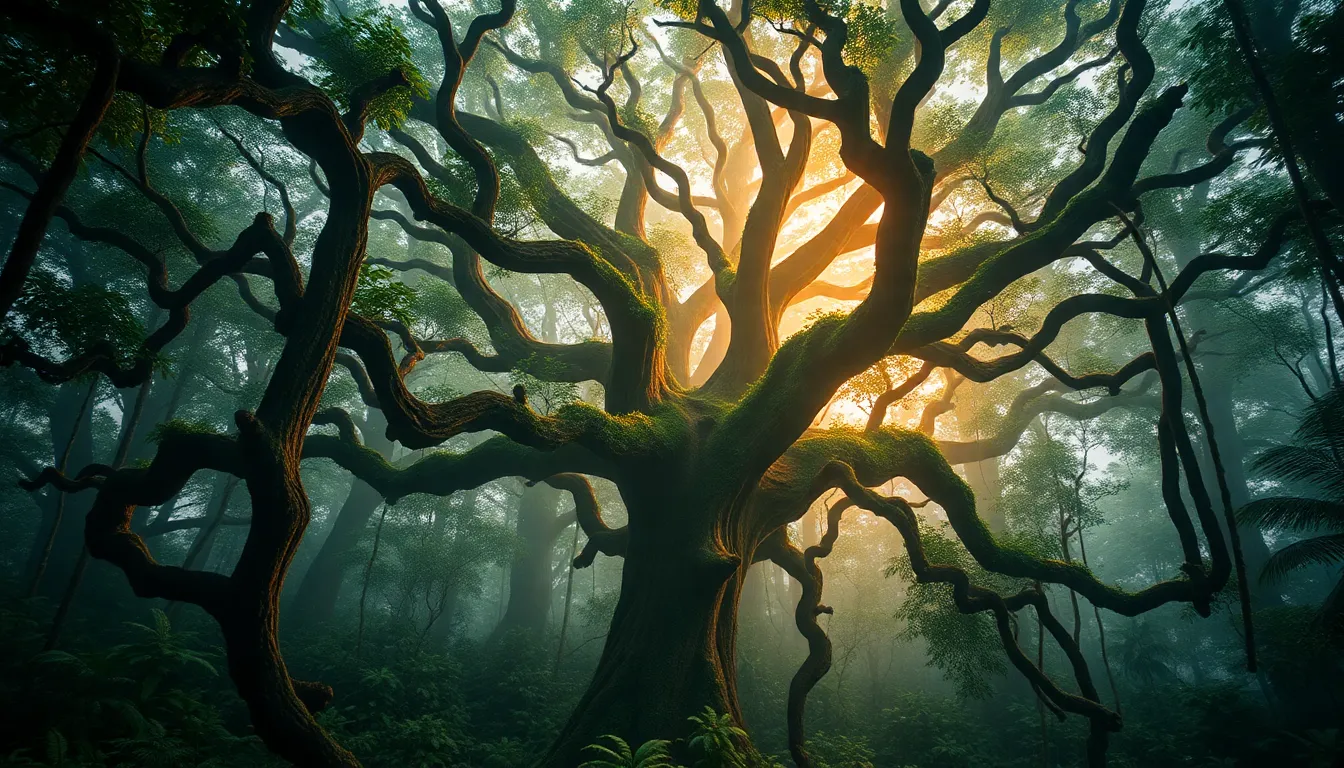The Sacred Trees of the Amazon: Myths of the Rainforest
I. Introduction
The Amazon Rainforest, often referred to as the lungs of the Earth, is a vast and intricate ecosystem that spans across several countries in South America. Home to an astounding variety of flora and fauna, the Amazon is not only critical for global biodiversity but also plays a significant role in the world’s climate regulation.
Within this lush landscape, trees hold a sacred place in the lives of Indigenous cultures. They are not merely resources but are interwoven into the spiritual, cultural, and daily lives of the people who inhabit this region. This article aims to explore the myths surrounding sacred trees in the Amazon, highlighting their ecological importance and cultural relevance.
II. The Ecological Significance of Sacred Trees
Trees in the Amazon are vital to maintaining ecological balance. They contribute to the environment in several ways:
- Role of trees in the Amazon ecosystem: Trees provide habitat and food for countless species, helping to sustain a rich biodiversity.
- Biodiversity and habitat preservation: The complex root systems and canopy layers of trees create microhabitats that support various organisms.
- Medicinal properties and traditional uses of sacred trees: Many trees are known for their medicinal qualities and are used in traditional healing practices.
III. Cultural Relevance of Sacred Trees in Indigenous Communities
For Indigenous communities, trees are often seen as sacred entities that embody spiritual significance and cultural heritage. They feature prominently in various aspects of life:
- Spiritual beliefs and practices involving trees: Many communities believe that trees are living beings that possess spirits or guardians.
- Symbolism of trees in creation myths: Trees often symbolize life, growth, and connectivity to ancestors in Indigenous folklore.
- Community rituals and celebrations surrounding trees: Trees are central to numerous social and religious ceremonies, marking important life events.
IV. The Legend of the Ceiba Tree
The Ceiba tree, with its towering height and expansive canopy, is a prominent figure in the Amazon rainforest. It is not only a vital part of the ecosystem but also rich in mythological significance:
- Description and characteristics of the Ceiba tree: Known for its large trunk and distinctive cotton-like flowers, the Ceiba can grow up to 200 feet tall.
- Myths surrounding the Ceiba in various Indigenous cultures: Many tribes view the Ceiba as a sacred tree that connects the earth to the heavens.
- The Ceiba as a bridge between worlds: It is often seen as a conduit between the physical and spiritual realms, facilitating communication with ancestors.
V. The Healing Power of the Palo Santo Tree
Palo Santo, or “holy wood,” is revered for its aromatic properties and its association with healing:
- Introduction to Palo Santo and its uses: This tree is often used in rituals, cleansing ceremonies, and traditional medicine.
- Myths and stories related to Palo Santo in Amazonian folklore: Stories often highlight its ability to ward off negative energies and bring good fortune.
- Modern-day applications and global recognition: Palo Santo has gained popularity worldwide for its therapeutic qualities, particularly in aromatherapy and holistic practices.
VI. The Mystery of the Brazil Nut Tree
The Brazil nut tree is another significant species in the Amazon, known for its unique ecological and economic contributions:
- Ecological role of the Brazil nut tree: This tree plays a crucial role in the rainforest ecosystem, supporting various wildlife species.
- Myths surrounding the Brazil nut in Indigenous communities: The Brazil nut is often viewed as a gift from the earth, integral to community sustenance.
- The tree’s impact on local economies and conservation efforts: Sustainable harvesting of Brazil nuts supports local economies and promotes forest conservation.
VII. The Symbolism of the Sacred Fig Tree
The Sacred Fig tree, or Ficus religiosa, holds a significant place in various cultures, especially in spiritual practices:
- Characteristics of the Sacred Fig tree: Known for its heart-shaped leaves and expansive canopy, this tree is often found in sacred groves.
- Myths and legends associated with the tree: Many legends speak of the tree’s role in enlightenment and spiritual awakening.
- Role of the Sacred Fig in meditation and spiritual practices: This tree is often a site for meditation and reflection, believed to enhance spiritual connectivity.
VIII. Threats to Sacred Trees and Their Myths
Despite their significance, sacred trees face numerous threats that jeopardize their existence and the cultural narratives surrounding them:
- Deforestation and its impact on sacred trees: Logging and land conversion for agriculture are rapidly depleting forest areas.
- Climate change and ecological disruption: Changing weather patterns threaten the health of forests and their ecosystems.
- The loss of cultural heritage and traditional knowledge: The decline of sacred trees leads to a disconnection from traditional practices and beliefs.
IX. Conservation Efforts and the Future of Sacred Trees
Recognizing the importance of sacred trees, various initiatives aim to protect these vital resources:
- Initiatives to protect sacred trees in the Amazon: Conservation programs are being developed to safeguard these trees and their ecosystems.
- The role of Indigenous knowledge in conservation: Indigenous practices and knowledge are essential for effective conservation strategies.
- How global awareness can contribute to preservation: Increased awareness and support for conservation can lead to positive changes and sustainable practices.
X. Conclusion
The sacred trees of the Amazon are not just biological entities; they are vital cultural symbols intertwined with the beliefs and traditions of Indigenous communities. Their myths reflect a deep connection to nature, spirituality, and community identity. As we face increasing environmental challenges, it is crucial to recognize the importance of these sacred trees and take action to conserve them. Protecting sacred trees means preserving not only the ecological health of the Amazon but also the cultural heritage of its Indigenous peoples. Through preservation efforts and global awareness, we can ensure that the sacred trees and their myths continue to thrive for generations to come.



